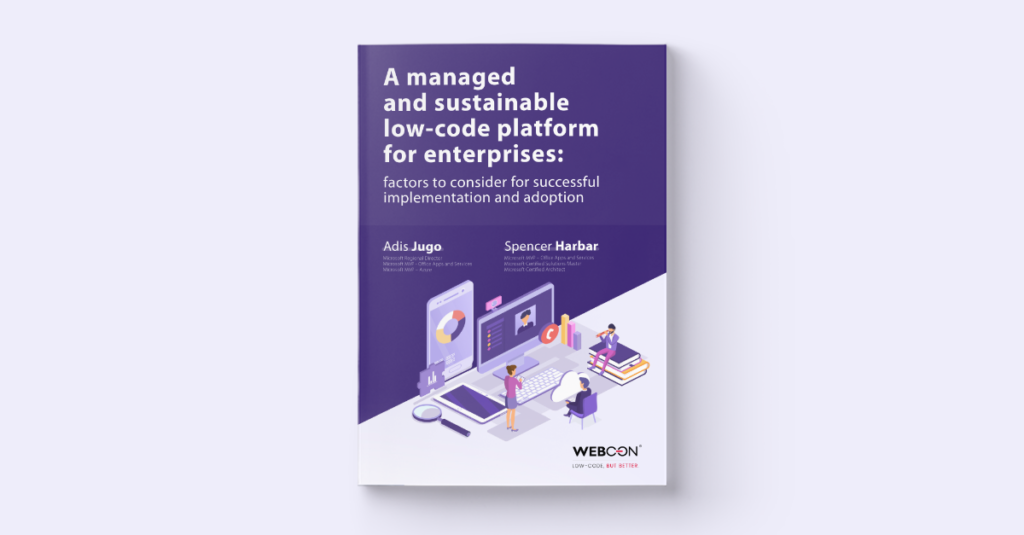In the age of digital transformation, much has already been written about the tasks and business process automation. Although every company approaches it slightly differently, there are several universal factors that should be kept in mind in order to implement improvements quickly and, above all else, to achieve the intended results and goals. After all, both business process automation and digitalization are meant to facilitate day-to-day business operations and generate a competitive advantage, not serve as an example of art for art’s sake, or an attempt to ride a currently popular trend. So, what should be taken into consideration when planning digital transformation? What processes should be given priority? Which methodology of implementation will work best?


Choose the tools for handling change with the future in mind
One of the most important and fundamental elements needed to achieve success in business process automation is choosing the right technology for the improvements you are introducing. The ever more popular low-code platforms are definitely worth considering here, as on the one hand they offer a huge suite of options and speed in developing tailor-made, fully functional solutions, while on the other hand they do not require us to depend on any single developer team.
The tool that we ultimately decide to use should allow us to place maximum focus on the substance of the processes we are automating, while retaining a simple and repeatable design for each business application we develop. A unified interface is a huge time saving for the implementation team, who can simply make use of elements previously applied in other configurations, without having to worry about what colors and icons to use in each project. In addition, a system that is visually coherent is easier to operate for users across all levels of technological proficiency.
When choosing an IT solution for your company, it is a good idea to gauge its reaction time to changes in the business environment that, for example, require access to applications to be modified or granting, workflow instances to be updated, or substitutions for absent employees handled. Having to function under the volatile conditions of running a business also means that the life cycle for certain business applications may eventually reach its end. Therefore, it is also important to have the option to safely archive such an application, without concern for loss of data or operational issues. There are several other noteworthy functionalities with a direct and practical impact not only on the business process automation, but also on their post-implementation maintenance and development. These include:
- an easy scalability and integration with other systems,
- reporting features,
- the option to add attachments and instructions for users,
- re-usability of mechanisms,
- transfer between different environments (DevTestProd),
- auto-documentation,
- auditability
- change log.
Get a bird’s eye perspective and worm’s eye view on the processes
A business process is more than a set of instructions on how to perform certain activities within a company. Rather, it is an operational manifestation of organizational policy. Simply becoming aware of this definition is enough to conclude that, when drawing up plans for business process automation, the first task should be to precisely map out and thoroughly understand the processes we wish to improve. This is true regardless of whether we want to automate a large area of our company’s activity, or just a single workflow. From the outset, we should be looking at the processes from an all-encompassing and holistic perspective.
Core processes usually include all those related to the outside component of running a business, including areas like customer relations. The latter group of processes includes the back-office systems that support the company and its employees on the back-end – e.g. managing absences, business trips or onboarding.
Sometimes one organization’s supportive processes turn out to be core in another; it all depends on the specifics of a given business. For example, for a company whose core activity is processing letters from customers within a period defined by statute, office processes that would usually be relegated to support by other businesses, gain core status – explains Aleksandra Kudera, Director of Implementation and Consulting at WEBCON.
Some businesses begin their business process automation by improving one specific process that causes the most difficulties at a given moment. Others choose to target not areas of activity, per se, but rather a selected group of end users, aiming to make their everyday work easier and more efficient. Others proceed immediately to digitalizing a core process, but implement the changes gradually, giving employees the opportunity to grow accustomed to the coming transformation. One thing is certain: regardless of the chosen variant, taking small steps, which in this case means applying automation to manage a single business process first, is most likely to bring success. The successful improvement of a specific workflow usually creates the need for further streamlining.
Pick the right implementation method to fit the nature of the project
Once we decide on the business process to improve, we should consider how much of the company’s activity is it involved in, how many departments contribute to its execution and what results we expect from its automation. The number of accurate and exhaustive answers to these questions will determine our optimal methodology for creating software and pursuing implementation work.
The classic waterfall approach will work well for projects in which we know exactly what it is we need and how we plan to achieve it. At the analysis stage, we write down the list of requirements for the project, set up a timeframe and choose which of the company’s existing procedures we wish to see modelled in the system. Then we go through traditional stages of the cascade model, which does not allow work on the next stage to commence unless the previous stage has been completed. The waterfall approach is usually applied to a company’s processes related to the areas of finance and quality, such as: invoices, orders, investment applications, budgeting or ISO procedures.
The agile methodology will be a good fit for projects recognized as having key features that we assume are likely to change over the course of implementation. Combined with the Pareto principle, whereby 80% of the results can be achieved with 20% of work, the agile approach introduces an entirely new paradigm for the delivery of IT solutions. We are no longer developing some distant final version of the system, but rather version 1.0, one that starts with all the basic functionalities, meaning that it is ready to use. A good example here would be a project management application. The only things we need to launch it in a production environment are:
- a list of projects,
- a list of employees working on a given project
- a list of tasks that we intend to assign to individuals.
Additional elements and more advanced functionalities can be added over subsequent versions, such as:
- reporting time,
- the verification of expenses
- the financial outlook for the project.
More importantly, continued development work on an already functioning application does not interfere with its day-to-day operations.
In the age of the Fourth Industrial Revolution, it is par for the course to see creative business departments deliver entire lists of ideas on how to improve their company and make it stand out from the competition. Not all of them will merit a full implementation in a production environment, but before making the decision to implement a new technology, it is a good idea to test it in a controlled environment first. This is the utility of the Proof-of-Concept approach, based on the methodologies of Rapid Prototyping and Failure-as-a-Service (FaaS). It functions as a test run of sorts, where, with only a sketch of an idea for a business application, we design an initial version and promptly proceed to testing it.
This gives us a quick and inexpensive way of checking whether the area we want to improve actually needs it, and whether a given department’s staff is ready for the changes and willing to use the new tool – explains Aleksandra Kudera, adding – if the tests reveal that the new technology is not useful or has no practical application, we can always postpone its development or even abandon it altogether, without feeling like we’ve lost any significant amount of time or money (Fast Fail).
Analyze the company’s technological environment and dependencies between the systems
The business process automation that entails the introduction of a new IT tool should be preceded by a diagnosis of the company’s existing IT architecture. The vast majority of companies, especially medium-sized and large ones, routinely use ERP software as a core system that records an organization’s business activity, as well as various domain specific systems that support the processes that account for the company’s market uniqueness and innovation. With the robust infrastructure of interdependent systems, introducing another IT system without proper consideration of these dependencies may cause it to have the opposite of the intended effect: instead of streamlining the work, we end up making it that much harder, while also making the organization’s IT ecosystem even more convoluted. To prevent this from happening, we have access to modern tools such as low-code business process automation platforms. These state-of-the-art BPM (Business Process Management) solutions work like an umbrella: regardless of how many middleware systems already function in a company, such a platform can cover them all through universal integration, organization and optimization of work.
The utilization of external technologies that are integrated with ERP software, while still retaining the ability to function autonomously, allows the companies to no longer concern themselves with growing maintenance costs for existing systems, difficulties with keeping these systems up to date or customization issues – assures Aleksandra Kudera. As a result, organizations can afford more flexibility, while IT employees gain superhero status in the eyes of their colleagues from business departments.
Describe the complexity of the business application being implemented
When deciding to business process automation and digitization, it is also worth considering the complexity of the business applications that we ultimately intend to create. It is easy to make an intuitive conclusion that the more complicated a business process is, the more advanced the application used to improve it will be. However, we should not treat that as a foregone conclusion. Sometimes, what is a simple application in one company (such as leave requests), can prove to be very complex in another.
Simple and easy to implement business applications (meaning a process that consists of two to three steps and several fields in a form), which companies often use as a jumping off point for digitization, include such things as:
- monitoring work time,
- archiving contracts,
- determining equipment needs,
- helpdesk management
- renting cars for business trips.
Quick success, low risk, the potential for development and a low barrier to entry for end users, are particularly good directions for those taking their first steps on the path towards digital transformation.
Complex applications are often unconventional systems equipped with multiple modules, robust forms and multi-stage approval processes.
One of the more interesting examples of such complicated solutions in our portfolio is a complex tool for handling heat supplies, designed for the leader of the heating sector in the Pomerania region. It combines a dozen or so business processes, starting from signing a contract to servicing a given facility, through communicating with teams and manipulating heat in radiators, to handling emergencies and processing complaints – lists Aleksandra Kudera.
Other complex applications may be related to such processes as:
- monitoring leasing and loans,
- managing production stages
- keeping track of employee attendance in an international company whose branches operate across different time zones.
The most complex and complicated solutions implemented by our customers are those that consist of many applications, where each involves 5, 10 or even 30 processes with robust forms, multi-stage approval and a large team working on them – she adds.
In all these cases, the use of high-quality, low-code business process automation platforms helps create a flexible and innovative ecosystem of standardized business applications, tailor-made and adjusted to fit the needs of a specific organization.
On average, our customers have already automated about 20 processes: from companies with only one running application to enterprises reaching as many as 300 applications with various levels of complexity and importance for the organization. Some companies automated two or three processes and stopped there for a while, only to become active again two or three years later, having come up with new ideas – summarizes Aleksandra Kudera.
About the Author







